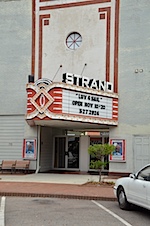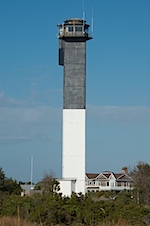Via Georgetown, SC.
We went across the Cape Fear River at Wilmington and headed down Route 17 towards South Carolina. We debated going going back down the peninsula to Fort Fisher on Cape Fear and taking the ferry across to Southport, but the ferry schedule helped us decide to drive instead.
Part way down we detoured off at the sign pointing to Brunswick Town and Fort Anderson. You can read All About It here, rather than let us get it wrong and not as well explained. Right next to it was the Orton Plantation which is clearly still in operation but farming pine trees for International Paper (that’s right, you do remember: the paper company that sold off its operations in Maine to concentrate on monoculture pine cropping in the SE US; drive through the town of Jay Maine and look at the tower in the middle of town, at the falls on the Androscoggin and admire the name still there: International Paper).
But part of the pleasure is just exactly this kind of of spur-of-the-moment little detour; the maps and guidebooks (unless you have some seriously detailed ones) don’t mention such places. At this season, the number of visitors midweek in November can likely be counted on the fingers of one finger. This site had some interesting archeology and displays, but unless you’re a serious student of Civil War torpedoes or Colonial artifacts, interest flags fast; it isn’t because the displays are not well-done – they are, and you have to admire the resources that the State spends here; they might cut budgets in any number of ways these days, and probably are doing so. Meanwhile we enjoy the work they put into educating the public about these bits of history.
The end of that route south led us to Southport, NC. This is another of the many ports along the ICW and is a thoroughly delightful place, with lots of interestingly history. It resembles Beaufort in the sense that it lies at the intersection of a number of waterways, harbors the station for the pilots for the Cape Fear River and Wilmington, and has a gorgeous old town with the classic wide-set-back streets of North Carolina with lines of beautiful live oaks overhanging them. When you look at the Google Map of the area you see that there are a lot of waterways meeting there. It’s a an area which has been punished by hurricanes but you’d never know it today. See more images of Southport. 
The live oak is a tree we’re learning to love on this trip. In Virginia they aren’t quite as impressive, but as you move south they assume really impressive size and are really gorgeous trees; they grow into enormous spreading trees, with wonderful twists in the trunks, and resist hurricane winds and salt spray. They were one of the principle shipbuilding timbers in the Colonial period and are reportedly responsible for cannonballs bouncing of the sides of Constitution (can anyone say “Old Ironsides”?).
A small find off the highway south of Southport, un-nnoticed by the guidebooks: Hampton Plantation State Park, an example of the low-country rice plantations. Gorgeous spot, with spectacular live oaks.
From Southport, NC, on into South Carolina, you want to avoid Myrtle Beach at all costs, and the State of South Carolina has made that possible with a lovely bypass. You end up in Georgetown, SC. We spent the night, and wanted to go to the Rice Museum the next morning but they were not open. We tend to think that King Cotton made the fortune of the South, but in this area, it was rice during the 1800’s, and the old homes in Georgetown demonstrate that clearly. Like Southport, it’s a town with wide set-back streets, live oaks and many lovely old houses (and an expected number of fixer-uppers), and what appears to be a

functioning movie theater, which was all lit up the night we were “downtown”.
Nowadays the southwestern horizon in G’Town outlines the mills of International Paper and Arcelor/Mittal Steel; why a a steel mill should be located in coastal South Carolina isn’t clear (though this article provides a little background), but there it is, and it’s an ugly hulk; but when the wind blows the wrong way, what you notice is the good ol’ hydrogen sulfide (i.e., rotten eggs) odor of a pulp mill. Otherwise it’s a lovely place.
Having time we wandered into Charlestown via Sullivan Island, looking for lunch (found) and to inspect the beaches, which are beautiful, and while heavily built up, the houses are at least set a couple of hundred yards back behind heavy vegetation on the low dunes. We added to the lighthouse collection here as well: and it has an unusual shape  to say the least.
to say the least.
Post a Comment